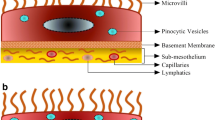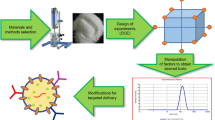We studied the effect of chronic intranasal and peroral administration of a new peptide preparation AСTH15-18PGP in a dose of 100 mg/kg body weight on the state of vascular-platelet and plasma hemostasis in animals. It was found that this synthetic regulatory peptide administered intranasally can produce antiplatelet, anticoagulant, and antifibrin-stabilizing effects on the blood plasma in healthy rats. In both administration routes, the peptide induced activation of the anticoagulation system of the hemostasis by increasing enzymatic and non-enzymatic fibrinolysis; after intranasal administration, the fibrinolytic effects were more pronounced.
Similar content being viewed by others
References
Levitskaya NG, Glazova NYu, Sebentsova EA, Manchenko DM, Vilenskii DA, Andreeva LA, Kamenskii AA, Myasoedov NF. Analysis of the spectrum of physiological activity of ACTH4-10 analog Semax heptapeptide. Neirokhimiya. 2008;25(1-2):111-118. Russian.
Levitskaya NG, Kamenskii AA. Melanocortin system. Uspekhi Fiziol. Nauk. 2009;40(1):44-65. Russian.
Lyapina KLA, Grigor’eva ME, Obergan TYu, Shubina TA. Theoretical and Practical Issues of Studying of the Functional State of the Blood Anticoagulant System. Moscow, 2012. Russian.
Lyapina LA, Grigor’eva ME, Shubina TA, Myasoedov NF, Andreeva LA. The modern concept of the regulatory role of peptides of the glyproline family in the correction of hemostasis system function during development of diabetes mellitus. Biol. Bull. 2013;40(4):386-393.
Manchenko DM, Glazova NYu, Levitskaya NG, Andreeva LA, Kamensky AA, Myasoedov NF. Nootropic and analgesic effects of Semax following different routes of administration. Ross. Fiziol. Zh. 2010;96(10):1014-1023. Russian.
Manual for the Study of Adhesion and Aggregation Activities of Platelets. Moscow, 2000. Russian.
Cherkasova KA, Lyapina LA, Ashmarin IP. Comparative study of modulatory effects of Semax and primary proline-containing peptides on hemostatic reactions. Bull. Exp. Biol. Med. 2001;132(1):625-626.
Yasnetsov VV, Chertorizhskii EA, Belyi PA, Bespalova ZhD, Ovchinnikov MV, Vereshchagina AO, Ivanov YuV, Yasnetsov VV, Karsanova SK, Motin VG. Study of Neuroprotective, Antihypoxic and Antiamnesic Effects of New Mixture of Tripeptides. Eksp. Klin. Farmakol. 2015;78(1):3-8. Rusian.
Arocas V, Bock SC, Raja S, Olson ST, Bjork I. Lysine 114 of antithrombin is of crucial importance for the affinity and kinetics of heparin pentasaccharide binding. J. Biol. Chem. 2001;276(47):43 809-43817.
Brzoska T, Tanaka-Murakami A, Suzuki Y, Sano H, Kanayama N, Urano T. Endogenously generated plasmin at the vascular wall injury site amplifies lysine binding site-dependent plasminogen accumulation in microthrombi. PLoS One. 2015;10(3). e0122196. doi: https://doi.org/10.1371/journal.pone.0122196.
Collet JP, Moen JL, Veklich YI, Gorkun OV, Lord ST, Montalescot G, Weisel JW. The alphaC domains of fibrinogen affect the structure of the fibrin clot, its physical properties, and its susceptibility to fibrinolysis. Blood. 2005;106(12):3824-3830.
Kridel SJ, Chan WW, Knauer DJ. Requirement of lysine residues outside of the proposed pentasaccharide binding region for high affinity heparin binding and activation of human antithrombin III. J. Biol. Chem. 1996;271(34):20 935-20 941.
Myasoedov NF, Lyapina LA, Andreeva LA, Obergan TY, Grigoryeva ME, Shubina TA. Oxoprolinic short peptides – potential pharmacological means of hypolidemic and antitrombotic actions. Biomed. Khim. 2017;63(6):546-552. doi: https://doi.org/10.18097/PBMC20176306546.
Napoli C, Stanley WC, Ignarro LJ. Nutrition and cardiovascular disease: Putting a pathogenic framework into focus. Cardiovasc. Res. 2007;73(2):253-256. doi: https://doi.org/10.1016/j.cardiores.2006.11.032
Vasilijevic A, Buzadzic B, Korac A, Petrovic V, Jankovic A, Korac B. Beneficial effects of L-arginine nitric oxide-producing pathway in rats treated with alloxan. J. Physiol. 2007;584(Pt 3):921-933.
Author information
Authors and Affiliations
Corresponding author
Additional information
Translated from Byulleten’ Eksperimental’noi Biologii i Meditsiny, Vol. 168, No. 8, pp. 205-208, August, 2019
Rights and permissions
About this article
Cite this article
Shubina, T.A., Obergan, T.Y., Lyapina, L.A. et al. Effect of a New Synthetic Peptide Preparation AСTH15-18PGP on the Hemostasis System in Rats. Bull Exp Biol Med 168, 250–253 (2019). https://doi.org/10.1007/s10517-019-04685-9
Received:
Published:
Issue Date:
DOI: https://doi.org/10.1007/s10517-019-04685-9




